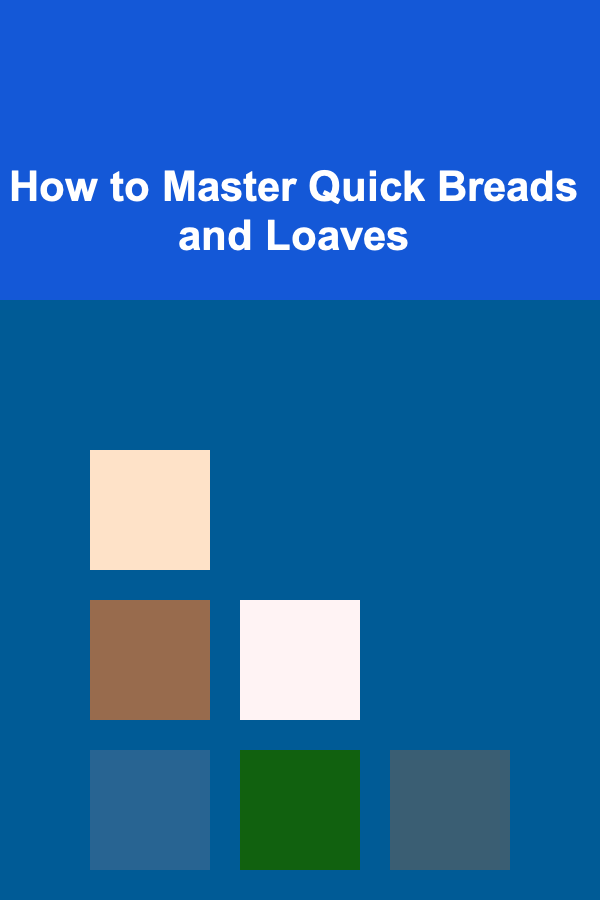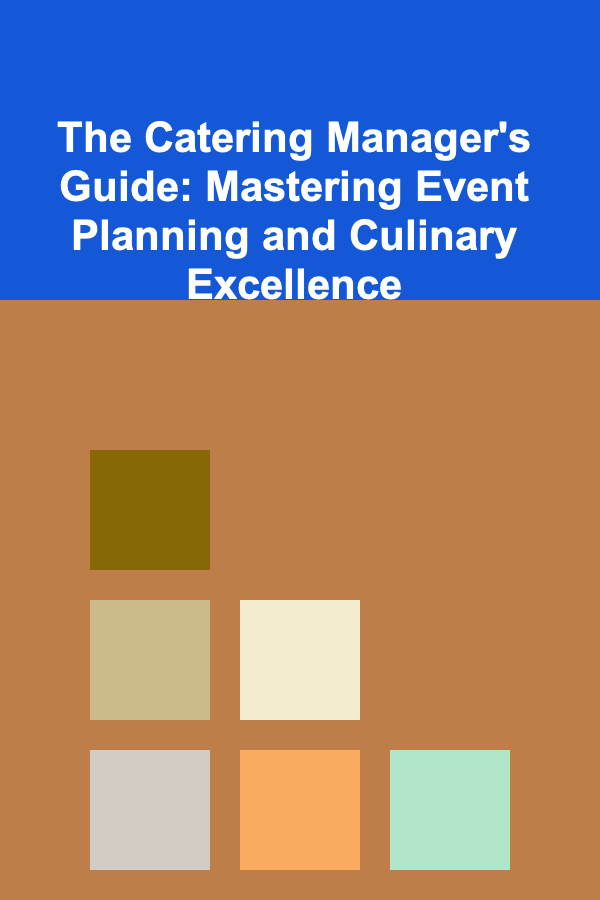
How to Master Quick Breads and Loaves
ebook include PDF & Audio bundle (Micro Guide)
$12.99$8.99
Limited Time Offer! Order within the next:

Quick breads and loaves are some of the most rewarding baked goods to make, particularly because they require no yeast and can be prepared in a fraction of the time it takes to make traditional yeasted bread. These baked goods, including banana bread, zucchini bread, and cornbread, are versatile, delicious, and surprisingly easy to perfect once you understand the fundamentals of their preparation.
In this article, we'll explore how to master quick breads and loaves by examining their core ingredients, essential techniques, common mistakes, and strategies to ensure success every time you bake. Whether you're a novice baker or an experienced home cook, mastering the art of quick breads will give you a powerful tool in your baking arsenal.
What Are Quick Breads?
Quick breads are a category of baked goods that rise without the use of yeast. Instead, they rely on chemical leavening agents such as baking powder, baking soda, or self-rising flour to achieve a light, fluffy texture. The defining feature of quick breads is their simplicity---no kneading, no rising time, and no need for special equipment.
There are many varieties of quick breads, including loaves, muffins, biscuits, and scones. Loaf-shaped quick breads are particularly popular for their ease of preparation, shelf life, and versatility in flavors and ingredients. Common examples of quick bread loaves include:
- Banana Bread
- Zucchini Bread
- Pumpkin Bread
- Cornbread
- Carrot Cake Bread
While the flavor profiles and ingredients may differ, the essential techniques and principles behind making these breads remain largely the same.
Key Ingredients in Quick Breads
Understanding the function of each ingredient is crucial when mastering quick breads. Below, we break down the key components that form the foundation of every quick bread recipe.
1. Flour
Flour provides the structure for quick breads. All-purpose flour is the most commonly used flour in quick bread recipes. However, depending on the type of bread you're making, you may substitute different flours, such as whole wheat flour, oat flour, or almond flour.
- All-purpose flour is best for creating a balanced texture that isn't too dense or too light.
- Whole wheat flour gives a denser, heartier texture and a more robust flavor.
- Gluten-free flours are suitable for people with gluten sensitivities but often require additional ingredients like xanthan gum to help with texture and rise.
2. Leavening Agents
Leavening agents are what make quick breads rise. Baking soda and baking powder are the two most common leaveners in quick bread recipes. Their primary function is to produce gas bubbles that cause the batter to expand during baking, resulting in a light texture.
- Baking soda requires an acid (such as buttermilk, lemon juice, or vinegar) to activate it. It is typically used in recipes that contain acidic ingredients.
- Baking powder contains both an acid and a base, so it doesn't require additional acidic ingredients to work. It's often used in recipes where there are no naturally acidic ingredients.
3. Fat
Fat contributes to the richness and tenderness of quick breads. Common fats used in quick breads include butter, vegetable oil, and sometimes lard or coconut oil.
- Butter imparts a rich, slightly savory flavor and creates a delicate crumb.
- Vegetable oil or canola oil are often used in recipes for a lighter texture and longer shelf life.
- Coconut oil can add a subtle coconut flavor and provides a rich, moist texture.
4. Sweeteners
Sweeteners are added to quick breads to provide flavor and balance out the acidity from the leavening agents. Common sweeteners include granulated sugar, brown sugar, maple syrup, and honey.
- Granulated sugar provides sweetness and helps with browning.
- Brown sugar adds moisture and a caramelized flavor due to the molasses content.
- Honey and maple syrup can be used for a more natural, complex sweetness.
5. Eggs
Eggs are a key ingredient in quick breads, serving as binders and providing structure. They also help with the leavening process by trapping air during mixing, which helps the bread rise.
- Large eggs are typically used in most recipes, but alternatives like flax eggs or chia eggs can be used for vegan versions.
6. Liquid
Liquid ingredients like milk, buttermilk, yogurt, or fruit juices hydrate the dry ingredients and help the batter reach the right consistency. The amount of liquid used can vary depending on the recipe and the type of bread you are making.
- Buttermilk adds a slight tanginess and tenderizes the crumb.
- Milk or cream provides moisture and a mild flavor.
- Fruit juices (like orange juice or apple cider) are sometimes used in fruit-based breads for added flavor.
7. Flavorings and Add-ins
Quick breads are highly customizable with additional flavorings and add-ins. These can include spices like cinnamon, nutmeg, or vanilla, as well as chunks of fruit, nuts, or chocolate. Popular add-ins include:
- Bananas for banana bread
- Shredded zucchini for zucchini bread
- Chopped nuts (walnuts, pecans, or almonds)
- Chocolate chips for sweet quick breads
- Dried fruits like cranberries or raisins
The sky is the limit when it comes to experimenting with flavors and ingredients in your quick bread recipes.
Essential Techniques for Making Quick Breads
While quick breads are relatively easy to make, there are several techniques that can help you achieve perfect results every time.
1. Mixing the Ingredients
Proper mixing is key to ensuring that your quick bread has the right texture and consistency. One of the most important things to remember is to avoid overmixing your batter.
- Mix dry ingredients first: In most quick bread recipes, it's important to first combine all the dry ingredients (flour, leavening agents, spices) in one bowl. This helps distribute the dry ingredients evenly throughout the batter.
- Combine wet ingredients separately: In another bowl, whisk together the wet ingredients (eggs, fat, liquid, sweeteners). Once these are well combined, pour them into the dry ingredients.
- Stir gently: When mixing the wet and dry ingredients together, use a gentle folding motion. Overmixing can develop too much gluten, resulting in dense, tough bread.
2. Properly Grease the Pan
Greasing the pan ensures that your bread comes out easily once it's baked. Use butter, shortening, or non-stick spray to grease the pan. You can also line the pan with parchment paper for extra insurance.
- For loaf pans, line the pan with parchment paper that extends over the edges so you can easily lift the bread out after it's baked.
3. Check the Consistency of the Batter
The consistency of the batter can vary depending on the type of bread you're making. For example, banana bread or zucchini bread batter should be thick and scoopable, while cornbread batter is often a bit more pourable.
- If your batter seems too thick, add a little more liquid. If it's too thin, add a little more flour or dry ingredients to achieve the right consistency.
4. Avoid Overbaking
Quick breads are easy to overbake, especially if you leave them in the oven for too long. Always check for doneness by inserting a toothpick or cake tester into the center of the bread. If it comes out clean or with just a few moist crumbs, the bread is ready.
- Time and temperature: Follow the recommended baking times in the recipe, but also keep an eye on the bread towards the end of the baking period. Baking times can vary depending on the size and type of pan used.
5. Cool the Bread Properly
Let your quick bread cool in the pan for about 10-15 minutes before transferring it to a wire rack. This ensures that the bread has set and won't fall apart when you remove it from the pan.
- Avoid cutting into the bread too soon. It's best to let it cool completely to allow the flavors to develop and the texture to set.
Common Mistakes to Avoid When Making Quick Breads
Even seasoned bakers can make mistakes when it comes to quick breads. Here are some common pitfalls and how to avoid them.
1. Overmixing the Batter
Overmixing the batter is one of the most common mistakes when making quick breads. This can lead to dense, heavy loaves because it develops too much gluten in the flour. Always mix until the ingredients are just combined.
2. Not Using the Right Pan
Using the wrong pan can lead to uneven baking. Make sure to use the pan size specified in the recipe. A larger or smaller pan can affect the cooking time and texture of the bread.
3. Too Much or Too Little Leavening
Getting the right amount of baking soda or baking powder is crucial. Too much leavening can result in a bread that rises too quickly and then collapses, while too little can lead to a dense, flat loaf. Always measure carefully.
4. Not Checking for Doneness
Don't rely solely on the recommended baking time. Ovens vary, so always check for doneness by inserting a toothpick or cake tester into the center of the bread. If it comes out clean, the bread is done.
5. Opening the Oven Door Too Early
Resist the urge to open the oven door during the first 15-20 minutes of baking. Opening the door too early can cause the bread to deflate and prevent it from rising properly.
Conclusion
Mastering quick breads and loaves is an achievable goal for any baker. By understanding the key ingredients, learning essential techniques, and avoiding common mistakes, you can create perfect, flavorful quick breads every time. The versatility of quick breads allows you to experiment with different flavors, textures, and ingredients, making them a fun and satisfying project for bakers of all skill levels.
With the right knowledge and a little practice, you'll be able to make everything from classic banana bread to exotic cornbreads, expanding your baking repertoire and enjoying the fruits of your labor. Happy baking!

How to Build a Retirement Planning Checklist for Emergency Funds in Retirement
Read More
How to Create a Cozy and Inviting Home with Staging
Read More
How to Use a Survey to Determine Family Interests
Read More
How to Use Festive Fabrics to Add Holiday Flair to Your Home
Read More
How to Use Magnetic Spice Racks to Save Space
Read More
The Catering Manager's Guide: Mastering Event Planning and Culinary Excellence
Read MoreOther Products

How to Build a Retirement Planning Checklist for Emergency Funds in Retirement
Read More
How to Create a Cozy and Inviting Home with Staging
Read More
How to Use a Survey to Determine Family Interests
Read More
How to Use Festive Fabrics to Add Holiday Flair to Your Home
Read More
How to Use Magnetic Spice Racks to Save Space
Read More